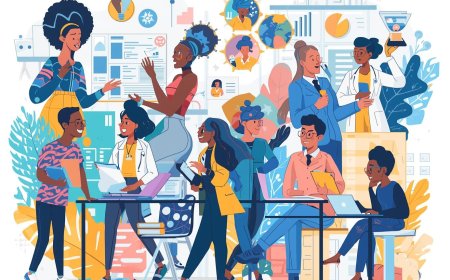From Hustle to High-Tech: The AI Growth Blueprint for the New Economy
A strategic blueprint for businesses, especially in Africa, on using Artificial Intelligence (AI) for marketing, sales, and scaling in the new economy. This guide covers core AI technologies, a customer journey framework, and a special focus on AI's transformative impact on the medical and healthcare industries, while maintaining global relevance.

Executive Summary
This report serves as a strategic blueprint for businesses, with a primary focus on the African context while maintaining global relevance, to harness the transformative power of Artificial Intelligence (AI) for marketing, sales, and sustainable scaling. The central argument is that AI is not merely an incremental tool but a fundamental agent of business transformation, enabling companies to leapfrog traditional growth models, particularly in dynamic and emerging economies. This document outlines the core AI technologies driving this shift, presents a comprehensive framework—the AI-Powered Growth Engine—for applying these technologies across the customer lifecycle, and provides an in-depth analysis of the unique opportunities and challenges within the African AI landscape. A dedicated spotlight on the medical and healthcare industries illustrates AI's profound impact on service delivery and patient outreach. The report culminates in an actionable implementation roadmap, emphasizing ethical governance and strategic foresight. Ultimately, it posits that adopting an AI-first mindset is no longer optional but an imperative for any business aiming to thrive in the new intelligent economy.
Part I: The Foundations of AI-Driven Growth
This section establishes a clear, strategic understanding of the core AI technologies that are reshaping the business world, moving beyond technical jargon to focus on their tangible value in creating a competitive advantage.
Section 1: Understanding the New Competitive Landscape
1.1 The Dawn of the Intelligent Economy
The "New Economy" is defined by a paradigm shift towards data-driven decision-making, hyper-personalization, and pervasive operational automation. In this landscape, Artificial Intelligence serves as the central nervous system, processing vast amounts of information to enable smarter, faster, and more efficient business operations.1 For startups and Small and Medium Enterprises (SMEs), particularly in Africa, AI adoption is a strategic necessity that levels the playing field. It provides the capabilities to operate at scale, analyze markets with sophisticated tools, and personalize customer interactions to a degree that was once the exclusive domain of large corporations with extensive resources.4
1.2 Demystifying the Core AI Technologies for Business Growth
A functional understanding of the key AI technologies is essential for strategic implementation. These technologies are not independent silos but interconnected engines that power modern business growth.
-
Machine Learning (ML): The Engine of Insight. At its core, Machine Learning involves algorithms that learn from data to identify patterns, make predictions, and automate decisions without being explicitly programmed for each task.5
-
Supervised Learning: This method uses labeled historical data to predict specific, known outcomes. For example, by training a model on past customer data labeled as "churned" or "retained," a business can predict which current customers are at the highest risk of leaving.8 It is the foundation for tasks like predictive lead scoring and sales forecasting.
-
Unsupervised Learning: This approach works with unlabeled data to discover hidden patterns and structures. Its most powerful application in marketing is customer segmentation, where it can identify new, emergent customer groups based on subtle behavioral similarities that a human analyst would never spot.8
-
Advanced Methods: Other techniques like semi-supervised learning are useful when only a small amount of labeled data is available, while reinforcement learning is applied in dynamic environments like real-time ad bidding, where the AI learns from the results of its own actions.8
-
Predictive Analytics: The Crystal Ball for Business. This branch of AI leverages historical data, statistical modeling, and machine learning to forecast future events. It represents a fundamental shift from reactive reporting (what happened) to proactive strategy (what will likely happen).10 Instead of just analyzing past sales, predictive analytics can anticipate future customer needs, predict campaign performance, and identify market trends before they become mainstream.13
-
Generative AI (GenAI): The Engine of Creation and Conversation. This category of AI, powered by Large Language Models (LLMs) like ChatGPT and Gemini, focuses on creating new, original content. It can generate text, images, and code from simple natural language prompts.15 In business, this revolutionizes content marketing by automating the creation of blog posts and ad copy, and enhances customer interaction through intelligent, human-like conversational chatbots.16
These technologies form a powerful, synergistic loop. Machine learning algorithms are the foundational layer, analyzing historical data to uncover critical patterns.5 Predictive analytics models then use these patterns to build the forecasting layer, predicting future behaviors like a customer's likelihood to purchase a specific product.10 Finally, generative AI acts as the creation layer, taking that specific prediction and generating a hyper-personalized marketing email or social media ad tailored to that individual customer's predicted interest.16 Effective generative AI in marketing is therefore not simply the result of a clever prompt; it is the culmination of robust data analysis and accurate predictive insights, making a holistic, integrated strategy essential for success.
1.3 From Data to Decisions: Your Most Valuable Asset, Activated
AI's primary function is to transform the abstract concept of "big data" into tangible, actionable business intelligence.1 Businesses today collect enormous volumes of both structured data (e.g., sales figures, customer demographics) and unstructured data (e.g., social media comments, customer support emails). AI's unique power lies in its ability to process these massive, complex datasets at a speed and scale far beyond human capability, uncovering subtle correlations and insights that drive strategy.1 This establishes data not as a mere byproduct of business activities, but as the essential fuel for the entire AI-powered growth engine.
Part II: The AI-Powered Growth Engine: A Customer Journey Framework
This framework details the application of AI at each stage of the customer lifecycle, providing a blueprint for optimizing business processes from initial market positioning to long-term customer retention.
Section 2: Positioning and Intelligence: Winning Before You Start
2.1 AI-Driven Market and Competitor Research
Effective strategy begins with a deep understanding of the market landscape. AI tools can provide this intelligence in real time by aggregating and analyzing data from social media, news articles, and customer reviews to gauge brand perception and identify emerging consumer trends.1 Specialized platforms can conduct AI-driven market research to uncover new opportunities and gather competitive intelligence on other providers, allowing businesses to benchmark their services, identify gaps in the market, and position their offerings more effectively.21
2.2 Predictive Customer Segmentation: From Demographics to Destiny
Traditional customer segmentation based on broad demographic categories like age and location is increasingly obsolete. AI facilitates a move towards dynamic, behavior-driven segmentation that groups customers based on their actual interactions with a brand.23 Using unsupervised machine learning models, AI can analyze browsing history, purchase patterns, and engagement levels to identify highly specific "micro-segments".7
Crucially, AI enables predictive segmentation, which forecasts future behaviors. This allows businesses to target customers not based on who they are today, but on who they are likely to become tomorrow—such as being at risk of churn, ready for an upgrade, or having a high potential lifetime value.24 This represents a fundamental strategic shift from descriptive marketing (targeting based on past attributes) to predictive marketing (targeting based on future potential).
Section 3: Marketing and Engagement: Creating Demand at Scale
3.1 The Hyper-Personalization Imperative
AI is the engine behind true hyper-personalization, analyzing individual user data to deliver tailored content, product recommendations, and offers in real time.13 This capability extends far beyond simple tactics like inserting a customer's name into an email. It involves dynamically altering website content, mobile app layouts, and promotional offers based on a user's predicted intent, creating an experience that feels uniquely crafted for each individual.17
3.2 Automated Content Creation & SEO Strategy
Generative AI tools such as Jasper, Writer, and Claude can dramatically accelerate the content creation process. They can brainstorm ideas, draft outlines, and generate high-quality first drafts of blog posts, social media updates, and advertising copy, freeing up marketing teams to focus on strategy.13 To ensure this content reaches its intended audience, AI-powered SEO platforms like SurferSEO and MarketMuse analyze search trends and competitor strategies to optimize content with the right keywords and structure, maximizing visibility and organic traffic.20
3.3 Intelligent Campaign Management
AI optimizes marketing campaigns by making data-driven recommendations on which channels to prioritize and the ideal timing for launches.6 Its most significant advantage is real-time optimization. AI algorithms can monitor campaign performance as it happens and automatically adjust parameters—such as ad spend allocation, audience targeting, and messaging—to maximize return on investment (ROI).28 Furthermore, AI-powered A/B testing platforms like Optimizely can rapidly test thousands of variations of headlines, images, and calls-to-action to scientifically determine the most effective creative combinations for each audience segment.7
Section 4: Sales and Conversion: Selling Smarter and Faster
4.1 Predictive Lead Scoring and Qualification
One of the most impactful applications of AI in sales is predictive lead scoring. AI models analyze a vast array of signals—including firmographic data, website behavior, and engagement with marketing materials—to accurately predict which leads are most likely to convert into paying customers.4 This automated qualification process allows sales teams to prioritize their efforts on high-potential prospects, dramatically increasing their efficiency and conversion rates by no longer wasting time on leads with a low probability of closing.32
4.2 Sales Process Automation: Freeing Reps to Sell
AI-powered sales automation platforms like HubSpot Sales Hub, Salesforce Einstein, and Outreach are designed to handle the repetitive, administrative tasks that consume a significant portion of a sales representative's day. This includes automated data entry into CRM systems, scheduling follow-up meetings, and executing personalized outreach sequences across email and social media.4 Unlike traditional, rule-based automation, AI-driven systems learn and adapt. They analyze prospect responses and engagement to refine messaging and timing, continuously improving the effectiveness of the outreach process over time.4
4.3 AI-Powered Forecasting and Pipeline Analysis
AI significantly enhances the accuracy of sales forecasting by analyzing historical sales data, deal progression velocity, and broader market trends to generate more reliable revenue projections.5 Beyond forecasting, AI provides deep "deal intelligence." These tools can analyze the entire sales pipeline to flag deals that are at risk of being lost, identify overlooked opportunities with a high probability of success, and provide sales managers with a clear, data-backed dashboard of pipeline health.33
Section 5: Support and Retention: Building Lasting Relationships
5.1 Intelligent Customer Service: 24/7, Personalized Support
AI-powered agents and chatbots, offered by platforms like Tidio and Ada, provide instant, 24/7 support across multiple channels and languages.21 Modern conversational AI has evolved far beyond simple, scripted responses to frequently asked questions. These systems can now understand complex user intent, access customer history to personalize interactions, and autonomously resolve up to 80% of routine inquiries. This frees human support agents to focus their expertise on high-value, complex, or emotionally sensitive customer issues.34
5.2 Predicting and Preventing Customer Churn
For any business, especially those with subscription models, customer retention is paramount. Predictive analytics offers a powerful solution by identifying customers who are at risk of churning.9 By analyzing data points such as product usage frequency, recent support interactions, and declining engagement levels, AI models can generate a "churn risk score" for each customer. This allows the business to proactively intervene with targeted retention campaigns, special offers, or personalized support outreach before the customer decides to leave, significantly improving customer lifetime value.9
The traditional, linear model of a customer "funnel"—where a lead moves sequentially from marketing to sales to support—is being fundamentally replaced by a cyclical, AI-driven ecosystem. The data collected during customer support interactions is no longer an endpoint; it is a critical input.16 This rich, qualitative data on customer pain points, feature requests, and common questions is fed back into the system. AI-driven market intelligence and segmentation models then analyze this support data to refine customer personas and identify unmet needs.1 These newly sharpened insights, in turn, inform the next generation of hyper-personalized marketing campaigns and can even guide future product development. This creates a self-improving "Customer Intelligence Loop," where support interactions directly fuel market intelligence, which sharpens marketing, leading to better-qualified customers who provide even more nuanced data back to the support system. Businesses that fail to create this feedback loop, leaving their support data siloed, will be operating with a significant competitive blind spot.
Part III: The African AI Frontier: A Continental Perspective
This section tailors the global AI narrative to the specific context of Africa, analyzing the continent's unique combination of immense growth potential and significant structural challenges. It highlights how African innovators are not just adopting AI but adapting it to solve local problems.
Section 6: Africa's AI Renaissance: Opportunities in a Dynamic Market
6.1 The Growth Trajectory: A Multi-Billion Dollar Opportunity
Africa's AI market is on a trajectory of explosive growth, projected to expand from US$4.5 billion in 2025 to US$16.5 billion by 2030.37 The economic impact is substantial, with generative AI alone holding the potential to unlock up to $100 billion in annual value across the continent's key sectors.[38, 39] This potential is attracting significant investment, with venture capital flowing into technology hubs in South Africa, Nigeria, and Kenya, complemented by major commitments from global technology giants like Google, which has pledged US$1 billion to support digital transformation in Africa.37
6.2 Mapping the Ecosystem: Policy, Hubs, and National Strategies
Recognizing AI's potential, governments and regional bodies are actively developing a supportive policy landscape. The African Union's Continental AI Strategy provides a high-level framework, while numerous countries—including Nigeria, Kenya, South Africa, Ethiopia, and Mauritius—have published national strategies that position AI as a critical enabler of socioeconomic development.39 This policy momentum is fostering the growth of AI hubs and research centers, such as Morocco's International Center for AI and South Africa's ambitious plan to develop 300 AI startups and train 5,000 AI professionals by 2030.37
6.3 Showcasing Success: African Innovators Harnessing AI
The "hustle to high-tech" journey is best illustrated by the innovative ways African companies are applying AI to solve pressing local challenges:
-
Fintech & Financial Inclusion: In Nigeria, Kudi.ai utilizes chatbots on platforms like Telegram to facilitate conversational banking, while Ghana's Paybox has embedded an AI tool within WhatsApp to help users track their finances. The platform Jumo, operating across several African nations, uses AI to create tailored financial products for underbanked populations.37 Telecom giant Safaricom in Kenya employs its "Zuri" chatbot to handle thousands of customer queries daily, generating personalized recommendations for its base of over 40 million users.43
-
Entrepreneurship: In Senegal, the startup CONCREE developed ADIA, an AI-driven tool that assists young entrepreneurs in drafting formal business plans, a critical step for securing financing and formalizing their ventures.42
-
Agriculture: Ghana-based Farmerline is using AI-powered sentiment analysis to process voice notes from farmers. This allows the company to identify common challenges and frustrations, enabling them to provide more targeted and effective support services.42
-
Logistics: In Uganda, 3D Services Limited has introduced the DASH AI, an AI-powered dashcam equipped with advanced safety features. This technology is enhancing road safety for the critical cross-border logistics sector by alerting drivers to potential hazards in real time.42
Section 7: Navigating the Terrain: Overcoming Barriers to Adoption
7.1 The Foundational Challenges: Infrastructure and Data
Despite the immense potential, significant foundational barriers remain.
-
Infrastructure Deficit: Unreliable electricity grids, frequent power outages, and limited internet connectivity—with only about 37% of Africans having internet access—pose major hurdles for AI systems that require stable power and high-speed connections.44 The continent also suffers from a lack of local data centers outside of a few hubs like South Africa, which increases data latency and operational costs for cloud-based AI applications.38
-
Data Scarcity & Quality: Effective AI models require vast amounts of high-quality, relevant data for training. Africa faces a challenge of "data deserts," where such data is often unavailable, unstructured, or siloed within government and private institutions. This scarcity risks creating biased AI models that do not accurately reflect the continent's diverse populations.38
7.2 The Human Element: Building a Pipeline of AI Talent
There is a recognized shortage of professionals with specialized AI and machine learning expertise across the continent, a problem compounded by a "brain drain" of existing talent to other regions.38 Addressing this requires a concerted effort in human capital development. Promising solutions include investing in local training programs, fostering partnerships between businesses and universities, and upskilling the existing workforce. Organizations like Data Science Nigeria and the African Institute for Mathematical Sciences (AIMS) are at the forefront of building this crucial talent pipeline.40
7.3 The Governance Gap: Regulation, Cost, and Security
The regulatory environment for AI and data privacy is fragmented and still evolving across Africa, creating uncertainty for businesses looking to deploy AI solutions at scale.38 Furthermore, the high upfront costs of specialized AI hardware and software, sometimes exacerbated by import tariffs, can be a significant barrier to entry, particularly for SMEs.44
|
Challenge |
Description |
Business Impact |
Strategic Mitigation |
|
Infrastructure Deficit |
Unreliable power, low internet penetration, lack of local data centers.38 |
Disrupts model training, increases latency and operational costs, limits real-time applications. |
Prioritize low-bandwidth, mobile-first solutions (e.g., USSD, WhatsApp bots); explore edge computing; partner with local data centers where available. |
|
Data Scarcity & Quality |
Lack of local, structured datasets; underrepresentation of African data in global models, leading to bias.45 |
Inaccurate models, biased and discriminatory outcomes, ineffective solutions. |
Invest in first-party data collection; use unconventional data sources (e.g., voice, satellite imagery); partner for data enrichment; implement rigorous bias auditing. |
|
Talent Shortage |
Lack of specialized AI skills (ML engineering, data science) and "brain drain" of existing experts.38 |
Inability to build, deploy, and maintain custom AI solutions; reliance on foreign expertise. |
Invest in internal upskilling programs; partner with local universities and tech hubs (e.g., AIMS); leverage low-code/no-code AI platforms to empower non-technical staff. |
|
Regulatory Uncertainty |
Fragmented and developing data privacy laws (e.g., POPIA, GDPR-like) and AI-specific policies across the continent.38 |
Compliance risks, legal challenges, discourages cross-border investment and data sharing. |
Adopt a "privacy-by-design" approach; build a flexible governance framework based on global best practices; monitor and adapt to key local laws. |
|
High Costs |
Significant investment required for AI hardware (e.g., GPUs), software subscriptions, and specialized talent.44 |
High barrier to entry, particularly for startups and SMEs, slowing down adoption. |
Prioritize open-source models and tools; start with high-ROI "quick win" projects; adopt a cloud-first strategy to reduce upfront hardware investment. |
These primary barriers to AI adoption in Africa have inadvertently fostered a unique ecosystem of "constraint-driven innovation." The severe limitations in infrastructure and traditional data sources force innovators to develop solutions that are fundamentally different from those in high-resource environments. Successful African AI ventures are often those that are ingeniously adaptive. For instance, companies like Paybox and Kudi.ai leverage ubiquitous, low-bandwidth platforms like WhatsApp as their primary interface, bypassing the need for users to download new, data-intensive applications.37 Similarly, Farmerline's use of voice notes for sentiment analysis turns an unstructured, low-tech data format into a valuable asset.42 This demonstrates a powerful pattern: the constraints themselves are compelling the creation of a more resilient, context-aware, and accessible form of AI. The strategic implication for businesses is to shift focus from replicating Western AI models to identifying readily available, low-bandwidth data sources that can be used to solve core local problems.
Part IV: Sector Spotlight: Transforming Healthcare with AI
This section provides a deep dive into the application of AI within the medical and healthcare industries, blending an analysis of global best practices with a focus on the groundbreaking innovations occurring across Africa. The following table highlights some of the most impactful AI-driven healthcare initiatives on the continent.
|
Initiative/Company |
Country |
AI Application |
Core Challenge Addressed |
Quantifiable Impact |
|
Zipline |
Rwanda |
AI-powered logistics for drone delivery |
Lack of road infrastructure for medical supply chains |
75% of national blood supply delivered; 51% drop in postpartum hemorrhage deaths 47 |
|
Ubenwa |
Nigeria |
ML analysis of infant cry patterns |
Lack of specialists for early detection of birth asphyxia |
Provides a low-cost, scalable diagnostic tool for low-resource clinics 47 |
|
Makerere University AI Lab |
Uganda |
Deep learning for malaria diagnosis from blood smears |
Overburdened lab technicians and diagnostic delays |
Achieves high accuracy and speed, freeing up scarce human resources 51 |
|
Audere (HIV Prevention) |
South Africa, Zimbabwe |
Empathetic AI chatbots |
Social stigma preventing youth from seeking HIV information |
Provides confidential, accessible, and timely health information to at-risk populations 51 |
|
Stellenbosch University (COVID-19) |
South Africa |
ML for disease spread modeling |
Need for data-driven public health policy during a pandemic |
Accurately predicted infection peaks, informing lockdown and vaccine strategies 47 |
Section 8: AI in Healthcare Marketing and Patient Outreach
8.1 Personalizing the Patient Journey
In healthcare, AI can optimize marketing and outreach by analyzing market perception and patient demographics to create more resonant and targeted public health campaigns or service announcements.22 By creating a unified view of a patient from disparate sources like Electronic Health Records (EHRs), billing systems, and patient portals, platforms such as Salesforce Health Cloud can enable highly personalized communications, such as tailored care plan reminders or targeted information for healthcare providers based on their specialty.52 However, this level of personalization requires a delicate and rigorous approach to data privacy, as even inferred health information is highly sensitive and subject to strict ethical and legal standards.50
8.2 Case Studies: Global Leaders in AI Healthcare Marketing
Global healthcare and pharmaceutical companies provide models for how AI can be effectively deployed. Bayer, for example, executed a digital rebranding strategy using targeted social media campaigns and user-friendly web content to build brand trust and educate consumers.54 The collaboration between CVS Health and Aetna in the United States demonstrates the power of integrating insurance and pharmacy data to identify patient needs more accurately and deliver personalized care plans through local health hubs.54 Meanwhile, AI-powered market research solutions like MD Analytics are crucial for pharmaceutical companies, assisting with demand forecasting, pricing research, and analyzing the patient journey from diagnosis to treatment.22
8.3 Innovations in Patient Outreach in Africa
In Africa, where access to healthcare professionals can be limited, AI is being used to bridge the information gap and extend the reach of health programs. A prime example is the work of Audere, which is testing empathetic AI-powered chatbots in Zimbabwe and South Africa. These chatbots provide young people with a confidential and accessible channel to receive timely information about HIV prevention, overcoming the social stigma that can deter them from visiting traditional clinics.51 By handling first-line health questions, these AI tools free up scarce clinicians to focus on more complex cases. Recognizing this potential, major health initiatives like the U.S. President's Emergency Plan for AIDS Relief (PEPFAR) are now encouraging the use of AI as a tool to improve and scale patient outreach efforts.51
Section 9: Scaling Healthcare Operations with AI
9.1 The Telehealth Revolution, Amplified by AI
AI is elevating telemedicine from a simple video conferencing tool to a sophisticated, proactive care delivery platform.55 AI-powered virtual assistants and chatbots, like Your.MD, offer 24/7 preliminary consultations, while AI-assisted diagnostic tools can remotely analyze medical images such as X-rays and CT scans with high accuracy.55 Furthermore, AI-driven remote patient monitoring systems analyze real-time data from wearable devices to predict health risks and alert providers to potential issues before they become critical. To ensure patient safety and build trust, these systems must be built on frameworks of Trustworthy AI (TAI), which prioritize transparency, ethical compliance, and data security.56
9.2 Operational Efficiency: Optimizing Scarce Resources
AI-powered process automation can significantly improve the efficiency of healthcare operations by managing tasks like patient scheduling, billing, and administrative reporting.22 In resource-constrained environments, this is particularly valuable. For instance, predictive analytics can optimize the allocation of scarce resources like ICU beds. A case study in Nigeria demonstrated that using AI for this purpose led to a 70% improvement in resource utilization.57 AI is also being deployed to detect fraud in medical insurance claims, which can speed up reimbursements and reduce administrative overhead for providers.58
9.3 African Case Studies: AI-Driven Healthcare in Action
The most compelling evidence of AI's impact comes from its application in solving Africa's unique healthcare challenges:
-
Logistics & Delivery: Zipline's use of AI to optimize drone flight paths in Rwanda has created a revolutionary delivery system for blood and medical supplies. This has not only made deliveries faster but has been credited with a 51% reduction in maternal deaths from postpartum hemorrhage.47
-
Diagnostics: In Uganda, the Makerere University AI Lab has developed algorithms that can diagnose malaria from blood smears with high accuracy, addressing the shortage of trained lab technicians.51 In Nigeria, the startup Ubenwa is using machine learning to analyze the sound of an infant's cry to detect early signs of birth asphyxia, a condition that requires immediate intervention.47 These tools bring diagnostic capabilities to low-resource settings that lack specialists and advanced equipment.
-
Disease Surveillance: During the COVID-19 pandemic, researchers in South Africa used machine learning models to accurately predict infection peaks, providing critical data to inform public health policies.47 These predictive models are now being adapted to combat long-standing health threats like tuberculosis and HIV, helping to personalize treatment plans and forecast outbreaks.57
In the African healthcare context, the most profound impact of AI lies not in merely optimizing existing high-tech systems, as is often the case in developed nations, but in creating entirely new pathways to care where none existed before. The continent's healthcare landscape is defined by systemic gaps: a shortage of clinicians, sparse infrastructure, and unequal access to services.47 The most successful AI initiatives directly address these gaps by functioning as a form of "surrogate infrastructure." Zipline, for example, did not just make hospital logistics more efficient; it created a reliable, temperature-controlled delivery network for remote clinics that was previously non-existent.47 Similarly, Ubenwa and the Makerere AI Lab provide diagnostic capabilities in settings where a specialist would never be available.47 The strategic implication is that the most scalable and impactful healthcare AI ventures in Africa will be those that build and own a new service delivery channel—be it logistical, diagnostic, or informational—rather than simply adding a software layer to existing, strained systems.
Part V: Building Your AI-Ready Business: A Strategic Implementation Roadmap
This final section provides an actionable guide for business leaders to strategically and responsibly integrate AI into their operations, with a strong emphasis on building a supportive culture and adhering to ethical principles.
Section 10: The Blueprint for Implementation
10.1 A Step-by-Step Guide to AI Adoption
A structured approach is essential for successful AI implementation. This can be broken down into four key phases:
-
Phase 1: Strategy & Audit: Begin by identifying specific business processes where AI can deliver the most value. Define clear, measurable objectives, such as reducing customer acquisition costs by 20% or improving sales forecast accuracy by 30%. This ensures that AI initiatives are directly tied to strategic business goals.4
-
Phase 2: Data & Tools: High-quality data is the foundation of any successful AI system. This phase involves collecting, cleaning, and preparing relevant datasets. Concurrently, select the right AI tools for the job, starting with "quick win" opportunities that can demonstrate value quickly and build momentum for broader adoption.4 The table below provides a curated list of tools for various functions.
-
Phase 3: Implementation & Training: Develop a clear implementation roadmap and integrate the selected AI tools into existing workflows. Critically, this phase must include comprehensive training for employees. The goal is to foster a collaborative environment where staff learn to work with AI as an augmentative tool, not against it as a replacement.4
-
Phase 4: Monitoring & Refinement: AI models are not static. Continuously monitor key performance indicators (KPIs) to measure the impact of AI initiatives. Establish feedback loops to regularly retrain and refine the models with new data, ensuring they remain accurate and effective over time.29
|
Category |
Function |
Example Tools |
Ideal for (Startup/SME/Enterprise) |
|
Market Research & Intelligence |
Market research, competitor analysis, social media sentiment analysis. |
CrawlQ, Hootsuite Insights, BuzzSumo 20 |
SME, Enterprise |
|
Content Creation & SEO |
AI-powered writing assistance, content generation, SEO optimization. |
Jasper, SurferSEO, MarketMuse, Writer 20 |
Startup, SME, Enterprise |
|
Personalization & Campaign Management |
A/B testing, cross-channel marketing automation, ad optimization. |
Optimizely, AdRoll, Albert.ai 20 |
SME, Enterprise |
|
CRM & Sales Automation |
Predictive lead scoring, pipeline management, automated outreach. |
Salesforce Einstein, HubSpot Sales Hub, Apollo.io, Outreach 4 |
Startup, SME, Enterprise |
|
Customer Support & Engagement |
AI chatbots, automated ticketing, intelligent agent assistance. |
Tidio, Ada, Zendesk AI, Intercom 17 |
Startup, SME, Enterprise |
10.2 Fostering a Data-Driven Culture
AI implementation is not merely a technological project; it is a cultural transformation. Success requires leadership to champion a data-driven mindset from the top down, demonstrating that strategic decisions should be guided by insights derived from data, not just intuition.1 This involves empowering employees at all levels with access to relevant data and the tools to interpret it, fostering a more agile, responsive, and intelligent organization.1
Section 11: Governance and Ethics: Building Trust in the Algorithmic Age
11.1 Universal Principles for Responsible AI
To build and maintain trust with customers, employees, and regulators, AI systems must be developed and deployed responsibly. This requires adherence to a set of core ethical principles, including: accountability, fairness, transparency, explainability, robustness, security, and privacy.63 A critical component of this is ensuring "meaningful human control," which means having a human-in-the-loop for critical decisions and the ability to override an AI system if it behaves unexpectedly. This maintains accountability and mitigates risks.63
11.2 The African Context: Addressing Algorithmic Bias and Data Colonialism
-
The Bias Problem: Algorithmic bias is a significant ethical challenge globally, but it is particularly acute in Africa. AI models trained on non-diverse, predominantly Western datasets can produce discriminatory outcomes when applied to African populations.48 This is not a theoretical risk; it has been demonstrated in healthcare, where pulse oximeters and skin cancer detection algorithms have shown lower accuracy for individuals with darker skin tones because they were trained on data from lighter-skinned patients.49
-
Healthcare Bias Case Study: A stark real-world example of this "algorithmic apartheid" occurred in South Africa, where a formal inquiry found that algorithms used by major medical aid schemes to detect fraud were biased against Black healthcare practitioners. The algorithms, intended to be objective, had inherited and amplified existing societal biases present in the historical data, leading to certain groups being unfairly targeted for investigation.49
-
Mitigation Strategies: Combating this requires a deliberate strategy to develop and train AI models on local, representative datasets. Furthermore, it involves integrating African cultural values and ethical frameworks, such as the philosophy of Ubuntu with its emphasis on community and interconnectedness, into the design of AI systems to ensure they are culturally sensitive and socially acceptable.67
11.3 Navigating Data Privacy and Security
Data privacy is a paramount concern, especially in a continent where many countries are still developing robust data protection laws and where data is often stored on servers outside of Africa.48 Businesses must proactively navigate this landscape by complying with existing regulations such as South Africa's Protection of Personal Information Act (POPIA) and Kenya's Data Protection Act, and by adhering to the principles of the AU's Malabo Convention.53 In the healthcare sector, the sensitivity of biomedical big data is extreme. Robust cybersecurity measures are non-negotiable to prevent data breaches, as highlighted by the 2023 ransomware attack on South Africa's National Health Laboratory Service (NHLS), which compromised vast amounts of sensitive patient information.53
Section 12: The Future is Intelligent: Charting Your Course
12.1 Emerging Trends: The Rise of Agentic AI
The evolution of AI is moving from being a "co-pilot" that assists humans to becoming an autonomous "agent" that can execute complex sequences of tasks. In the near future, AI agents will be able to handle end-to-end processes like identifying ideal customer profiles, finding contacts, personalizing outreach across multiple channels, and managing the entire lead generation cadence with minimal human supervision.3 This will inevitably transform the nature of work. Traditional roles like Sales Development Representatives (SDRs) may diminish, while new, more technical roles like "Go-to-Market Engineers," who specialize in designing and optimizing these AI-driven sales and marketing workflows, will become critical.3
12.2 The Road Ahead for African Businesses
For businesses across Africa, the rise of AI presents a historic "leapfrog" opportunity. Unencumbered by the complex legacy systems that can slow down incumbents in more developed markets, African companies have the chance to build AI-native business models from the ground up. The journey from hustle to high-tech requires more than just technology adoption; it demands a new way of thinking, innovating, and growing. The future will belong to those organizations that can successfully merge timeless human insight with the power of intelligent automation, creating businesses that are not only more efficient and profitable but also more responsive to the unique needs of their customers and communities.1
Works cited
-
How business leaders are using AI to make data-driven decisions - DataScienceCentral.com, accessed October 26, 2025, https://www.datasciencecentral.com/how-business-leaders-are-using-ai-to-make-data-driven-decisions/
-
Data-Driven Decision-Making with AI - Analytium, accessed October 26, 2025, https://analytium.com/resource-hub/data-driven-decision-making-with-ai
-
The Future of Sales: How AI and Automation Are Transforming Go-to-Market Strategies, accessed October 26, 2025, https://business.columbia.edu/insights/ai-automation-transforming-go-to-market-strategies
-
Best AI Sales Automation for Startups: The Complete 2025 Guide - Monday.com, accessed October 26, 2025, https://monday.com/blog/crm-and-sales/best-ai-sales-automation-for-startups/
-
What is Machine Learning in Sales? - Pipedrive, accessed October 26, 2025, https://www.pipedrive.com/en/blog/what-is-machine-learning
-
Machine Learning in Marketing: A Complete Guide - Mailchimp, accessed October 26, 2025, https://mailchimp.com/resources/machine-learning-in-marketing-guide/
-
10 Ways to Use Machine Learning for Marketing in 2025 - Analytics Vidhya, accessed October 26, 2025, https://www.analyticsvidhya.com/blog/2023/03/machine-learning-for-marketing/
-
Machine learning marketing that drives results | Braze, accessed October 26, 2025, https://www.braze.com/resources/articles/machine-learning-marketing
-
Machine learning use cases in digital marketing in 2025 - OWOX, accessed October 26, 2025, https://www.owox.com/blog/articles/machine-learning-in-marketing
-
What is Predictive Analytics in Marketing? (7 Use Cases) - Jetpack, accessed October 26, 2025, https://jetpack.com/resources/what-is-predictive-analytics-in-marketing/
-
What is Predictive Analytics? | IBM, accessed October 26, 2025, https://www.ibm.com/think/topics/predictive-analytics
-
How Predictive Analytics is Shaping the Future of Marketing - Champlain College Online, accessed October 26, 2025, https://online.champlain.edu/blog/how-predictive-analytics-is-shaping-the-future-of-marketing
-
5 Key Components of a Successful AI-Powered Marketing Strategy ..., accessed October 26, 2025, https://www.m1-project.com/blog/5-key-components-of-a-successful-ai-powered-marketing-strategy
-
4 Ways Predictive Marketing Can Guide Customer Purchases - Amplitude, accessed October 26, 2025, https://amplitude.com/blog/predictive-marketing
-
Real-world gen AI use cases from the world's leading organizations | Google Cloud Blog, accessed October 26, 2025, https://cloud.google.com/transform/101-real-world-generative-ai-use-cases-from-industry-leaders
-
Generative AI in Marketing - IBM, accessed October 26, 2025, https://www.ibm.com/think/topics/generative-ai-marketing
-
10 Best AI personalization tools for websites, apps, email, and more - Insider, accessed October 26, 2025, https://useinsider.com/ai-personalization-tools/
-
Generative AI in Marketing and Sales | Deloitte US, accessed October 26, 2025, https://www.deloitte.com/us/en/Industries/tmt/articles/generative-ai-in-marketing.html
-
How AI decision-making improves business outcomes - Lumenalta, accessed October 26, 2025, https://lumenalta.com/insights/how-ai-decision-making-improves-business-outcomes
-
25 best AI marketing tools for smarter workflows - Sprout Social, accessed October 26, 2025, https://sproutsocial.com/insights/ai-marketing-tools/
-
25 Best AI Marketing Tools Reviewed in 2025 - The CMO, accessed October 26, 2025, https://thecmo.com/tools/ai-marketing-tools/
-
23 Healthcare AI Use Cases with Examples - Research AIMultiple, accessed October 26, 2025, https://research.aimultiple.com/healthcare-ai-use-cases/
-
AI Customer Segmentation Strategies for Personalization in Marketing - Mailchimp, accessed October 26, 2025, https://mailchimp.com/resources/ai-customer-segmentation/
-
AI Customer Segmentation: How to Reach the Right Audience with Precision | M1-Project, accessed October 26, 2025, https://www.m1-project.com/blog/ai-customer-segmentation-how-to-reach-the-right-audience-with-precision
-
Unlock the Power of AI Customer Segmentation with AWS Marketplace - Amazon.com, accessed October 26, 2025, https://aws.amazon.com/marketplace/solutions/generative-ai/what-is/ai-customer-segmentation/
-
AI Customer Segmentation: What It Is and Why It Matters - 180ops, accessed October 26, 2025, https://www.180ops.com/blog/ai-customer-segmentation-what-it-is-and-why-it-matters
-
Revamp Your Marketing Campaigns With AI Customer Segmentation - Pecan AI, accessed October 26, 2025, https://www.pecan.ai/blog/ai-customer-segmentation-marketing/
-
25 AI Marketing Tools in eCommerce & Ad Intelligence - Clarity Ventures, accessed October 26, 2025, https://www.clarity-ventures.com/artificial-intelligence-ecommerce/ai-marketing-tools
-
AI Content Personalization: How to Tailor Marketing at Scale - Leadpages, accessed October 26, 2025, https://www.leadpages.com/blog/ai-content-personalization
-
AI In Marketing Statistics: How Marketers Use AI In 2025 - SurveyMonkey, accessed October 26, 2025, https://www.surveymonkey.com/mp/ai-marketing-statistics/
-
A guide to AI in marketing - IBM, accessed October 26, 2025, https://www.ibm.com/think/topics/ai-in-marketing
-
AI sales automation: 5 top tools to boost performance - Pipedrive, accessed October 26, 2025, https://www.pipedrive.com/en/blog/ai-sales-automation
-
The 2025 Guide to 16 Top AI Sales Tools - SPOTIO, accessed October 26, 2025, https://spotio.com/blog/ai-sales-tools/
-
AI in customer service: All you need to know - Zendesk, accessed October 26, 2025, https://www.zendesk.com/blog/ai-customer-service/
-
What is Intelligent Customer Service Automation? - NiCE, accessed October 26, 2025, https://www.nice.com/glossary/intelligent-customer-service-automation
-
AI Customer Service Agents For Quality CX At Scale | ada, accessed October 26, 2025, https://www.ada.cx/
-
Africa's AI Market Set to Quadruple by 2030, Driving Job Creation ..., accessed October 26, 2025, https://fintechnews.africa/45777/fintechafrica/africas-ai-market-set-to-quadruple-by-2030-driving-job-creation-financial-inclusion-and-innovation/
-
Leading, not lagging: Africa's gen AI opportunity - McKinsey, accessed October 26, 2025, https://www.mckinsey.com/capabilities/quantumblack/our-insights/leading-not-lagging-africas-gen-ai-opportunity
-
Understanding Africa's AI Governance Landscape: Insights From Policy Practice and Dialogue | Carnegie Endowment for International Peace, accessed October 26, 2025, https://carnegieendowment.org/posts/2025/09/understanding-africas-ai-governance-landscape-insights-from-policy-practice-and-dialogue?lang=en
-
Nationa AI policies in Africa - Diplo Resource - DiploFoundation, accessed October 26, 2025, https://www.diplomacy.edu/resource/report-stronger-digital-voices-from-africa/ai-africa-national-policies/
-
AI dominates GITEX: Can Africa seize the opportunity? - African Business, accessed October 26, 2025, https://african.business/2025/10/technology-information/ai-dominates-gitex-can-africa-seize-the-opportunity
-
Artificial Intelligence: Innovations across Africa | ITC, accessed October 26, 2025, https://www.intracen.org/news-and-events/news/artificial-intelligence-innovations-across-africa
-
Africa's AI Powerhouse: A New Era Driving Tech Innovation and Global Impact - Andela, accessed October 26, 2025, https://www.andela.com/blog-posts/africas-ai-powerhouse-a-new-era-driving-tech-innovation-and-global-impact
-
(PDF) AI adoption and sustainability of SMES in Africa: Opportunities ..., accessed October 26, 2025, https://www.researchgate.net/publication/388162117_AI_adoption_and_sustainability_of_SMES_in_Africa_Opportunities_and_challenges
-
8 Key Barriers Slowing AI Adoption in Africa, essentially developing countries. | by Otim Fredrick | Medium, accessed October 26, 2025, https://medium.com/@otimfredrick/8-key-barriers-slowing-ai-adoption-in-africa-c6b0afc0d6a0
-
Artificial Intelligence in Africa: Challenges and Opportunities - Policy Center, accessed October 26, 2025, https://www.policycenter.ma/publications/artificial-intelligence-africa-challenges-and-opportunities
-
AI-Powered Healthcare Revolution: How African Innovators Are Bridging the Medical Gap, accessed October 26, 2025, https://iafrica.com/ai-powered-healthcare-revolution-how-african-innovators-are-bridging-the-medical-gap/
-
AI in Africa rapid growth at the cost of Privacy and Ethics - MSMK, accessed October 26, 2025, https://msmk.university/ai-in-africa-rapid-growth-at-the-cost-of-privacy-and-ethics/
-
When the Algorithm is Blind: AI, Data Bias, and the South African Patient, accessed October 26, 2025, https://informationmatters.org/2025/10/when-the-algorithm-is-blind-ai-data-bias-and-the-south-african-patient/
-
DPAs and AI regulation in Africa - IAPP, accessed October 26, 2025, https://iapp.org/news/a/dpas-and-ai-regulation-in-africa
-
The Ethics of AI-Driven Health Projects in Africa, accessed October 26, 2025, https://www.thinkglobalhealth.org/article/the-ethics-of-ai-driven-health-projects-in-africa
-
AI in Healthcare Marketing: How to Balance Personalization and Privacy - Salesforce, accessed October 26, 2025, https://www.salesforce.com/blog/ai-healthcare-marketing/
-
Healthcare data protection in a mushrooming AI-driven sector - Juta MedicalBrief, accessed October 26, 2025, https://www.medicalbrief.co.za/healthcare-data-protection-in-a-mushrooming-ai-driven-sector/
-
Healthcare Marketing Case Studies [2025] - DigitalDefynd, accessed October 26, 2025, https://digitaldefynd.com/IQ/healthcare-marketing-case-studies/
-
AI in Telemedicine: Top Use Cases, Challenges & Future Trends, accessed October 26, 2025, https://appinventiv.com/blog/ai-in-telemedicine/
-
Trustworthy AI in Telehealth: Navigating Challenges, Ethical Considerations, and Future Opportunities for Equitable Healthcare Delivery - PubMed Central, accessed October 26, 2025, https://pmc.ncbi.nlm.nih.gov/articles/PMC12485827/
-
The Role of Artificial Intelligence in Strengthening Healthcare Delivery in Sub-Saharan Africa: Challenges and Opportunities - ResearchGate, accessed October 26, 2025, https://www.researchgate.net/publication/388224732_The_Role_of_Artificial_Intelligence_in_Strengthening_Healthcare_Delivery_in_Sub-Saharan_Africa_Challenges_and_Opportunities
-
AI in Healthcare in Africa - The Future Society, accessed October 26, 2025, https://thefuturesociety.org/wp-content/uploads/2022/02/AI-in-Healthcare-in-Africa-TFS-for-Mo-Ibrahim-Foundation-Forum-Report_vf.pdf
-
Challenges and opportunities of artificial intelligence in African health space - PMC - NIH, accessed October 26, 2025, https://pmc.ncbi.nlm.nih.gov/articles/PMC11748156/
-
Integrating artificial intelligence into African health systems and emergency response: Need for an ethical framework and guidelines - PMC - NIH, accessed October 26, 2025, https://pmc.ncbi.nlm.nih.gov/articles/PMC11966719/
-
(PDF) Revolutionizing African Healthcare: A Systematic Review of Artificial Intelligence and Data Governance - ResearchGate, accessed October 26, 2025, https://www.researchgate.net/publication/391471801_Revolutionizing_African_Healthcare_A_Systematic_Review_of_Artificial_Intelligence_and_Data_Governance
-
The Impact of AI on Data-driven Decision-making - Debut Infotech, accessed October 26, 2025, https://www.debutinfotech.com/blog/the-impact-of-ai-on-data-driven-decision-making
-
10 Universal Principles for Successful AI Implementation - MoreThanDigital, accessed October 26, 2025, https://morethandigital.info/en/10-universal-principles-for-successful-ai-implementation/
-
Scaling Generative AI: 13 elements for sustainable growth and value - Deloitte, accessed October 26, 2025, https://www.deloitte.com/us/en/services/consulting/articles/scaling-generative-ai-strategy-in-the-enterprise.html
-
What is AI Ethics? | IBM, accessed October 26, 2025, https://www.ibm.com/think/topics/ai-ethics
-
AI principles - OECD, accessed October 26, 2025, https://www.oecd.org/en/topics/ai-principles.html
-
ETHICAL AI DEVELOPMENT IN AFRICA: INTEGRATING CULTURAL VALUES AND ADDRESSING GLOBAL DISPARITIES - Centre for Intellectual Property and Information Technology Law, accessed October 26, 2025, https://cipit.org/ethical-ai-development-in-africa-integrating-cultural-values-and-addressing-global-disparities/
-
Africa, ChatGPT, and Generative AI Systems: Ethical Benefits, Concerns, and the Need for Governance - MDPI, accessed October 26, 2025, https://www.mdpi.com/2409-9287/9/3/80
-
Artificial intelligence in global health: An unfair future for health in Sub-Saharan Africa? - PMC - PubMed Central, accessed October 26, 2025, https://pmc.ncbi.nlm.nih.gov/articles/PMC11823112/
-
Overcoming AI Bias: Understanding, Identifying and Mitigating Algorithmic Bias in Healthcare - Accuray, accessed October 26, 2025, https://www.accuray.com/blog/overcoming-ai-bias-understanding-identifying-and-mitigating-algorithmic-bias-in-healthcare/
-
Practical, epistemic and normative implications of algorithmic bias in healthcare artificial intelligence: a qualitative study of multidisciplinary expert perspectives | Journal of Medical Ethics, accessed October 26, 2025, https://jme.bmj.com/content/51/6/420
-
ETHICAL AI DEVELOPMENT IN AFRICA: INTEGRATING CULTURAL VALUES AND ADDRESSING GLOBAL DISPARITIES - Centre for Intellectual Property and Information Technology law - cipit, accessed October 26, 2025, https://cipit.strathmore.edu/ethical-ai-development-in-africa-integrating-cultural-values-and-addressing-global-disparities/
-
Scale AI: Accelerate the Development of AI Applications, accessed October 26, 2025, https://scale.com/
-
Marketing in 2026: the future of AI in Marketing - Huble, accessed October 26, 2025, https://huble.com/blog/ai-in-marketing
What's Your Reaction?
 Like
0
Like
0
 Dislike
0
Dislike
0
 Love
0
Love
0
 Funny
0
Funny
0
 Angry
0
Angry
0
 Sad
0
Sad
0
 Wow
0
Wow
0













































